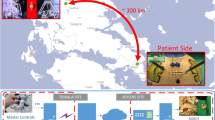Abstract
Object
We have developed a robotic minimally invasive surgical system within a tele-surgery capability and conducted several times of tele-surgery experiments including Japan–Thailand and Japan–Korea tele-surgery experiments by using conventional network infrastructures. In these experiments, laparoscopic cholecystectomies have been successfully performed on pigs. On the other hand, repetitive task evaluation studies are also crucial for further studies on tele-surgery applications. Nowadays, task evaluations of tele-robotic system within network time-delay have been studied in past years by many researchers. These experiments have been mostly focused on simplified tasks such as a peg-in-hole task. However, most of surgical procedures in minimally invasive surgery are based on medical specific skills such as anatomical knowledge and past experiences of surgeons. From these perspectives, a trial experiment within two tasks including surgery oriented manipulations was conducted to study the impact of network time-delay and force feedback on tele-surgery.
Materials and methods
The experiment was conducted by using the minimally invasive surgical system. As the experimental setup, a research and development Internet, JGN2 (Japan Gigabit Network 2) was used as a network infrastructure, and two tasks were performed by 15 subjects including 5 medical doctors. The trial conditions were given by changing time-delay (on the both tasks) and force feedback (on the first task). The first task was configured to test a simple surgical procedure, which is commonly performed in a laparoscopy as translational motions of surgical tools. The subjects were instructed to touch four columns located on points of a square. The second task was configured to test integrated surgical procedures. The subjects were instructed to perform a part of suturing procedures by using the robotic bending forceps.
Results
In the first task, the completion time was increased approximately 50% by time-delay. By using force feedback, the applied force was decreased. However, the effectiveness of force feedback was not strongly shown in MD group. On the other hand, the effectiveness of the force feedback was strongly shown in the applied force on the tip of surgical tool in both MD and non-MD groups. In the second task, the adverse impact of time-delay was not strongly shown in MD group. From the analysis of the motion records found that a skill of experienced surgeons on “occlusion problem” could be related in the results. These results indicate that skilful operators on surgical procedures can overcome the adverse impact of time-delay by introducing their skills depending on required surgical tasks. However, the drawback of time-delay still remains concerning on safety issues. The effectiveness of the force feedback was strongly shown in the first task in terms of the applied force on the surrounding environment.
Conclusions
Force feedback is an essential technology for further applications of tele-surgery. In addition, the force feedback technology can be partially used for compensating the drawback of time-delay.
Similar content being viewed by others
References
Marescaux J et al (2002) Transcontinental robot-assisted remote telesurgery: feasibility and potential applications. Ann Surg 235(4): 487–492 doi:10.1097/00000658-200204000-00005
Arata J, Mitsuishi M, Hashizume M et al (2007) Tele-surgery experiment between Japan–Thailand using high-speed Internet. Int J CARS 2(Suppl 1) S:196–198
Arata J, Mitsuishi M, Hashizume M et al (2007) A remote surgery experiment between Japan and Thailand over Internet using a low latency CODEC system. Proc IEEE Int Conf Robot Autom 953–959
Verner LN, Okamura AM (2007) Effects of translational and gripping force feedback are decoupled in a 4-degree-of-freedom telemanipulator. Proc IEEE World Haptics 286–291
Wagner CR, Howe RD (2005) Mechanisms of performance enhancement with force feedback. Proc IEEE World Haptics 21–29
Sheridan TB (1993) Space teleoperation through time delay: review and prognosis. IEEE Trans Robot Autom 9(5): 592–606 doi:10.1109/70.258052
Anderson RJ, Spong MW (1989) Bilateral control of teleoperators with time delay. IEEE Trans Automat Contr 34(5): 494–501 doi:10.1109/9.24201
Niemeyer G, Slotine JE (1991) Stable adaptive teleoperation. IEEE J Oceanic Eng 16(1): 152–162 doi:10.1109/48.64895
Hirzinger G, Brunner B, Dietrich J et al (1993) Sensor-based space robotics—ROTEX and Its telerobotic features. IEEE Trans Robot Autom 9(5): 649–663 doi:10.1109/70.258056
Oyama T et al (2003) New edition of sensation, perception psychology handbook. ISBN4-414-30503-9
Katsuura T et al (1992) Ergonomics criterion measure handbook. ISBN-10:4765500217
Author information
Authors and Affiliations
Corresponding author
Rights and permissions
About this article
Cite this article
Arata, J., Takahashi, H., Yasunaka, S. et al. Impact of network time-delay and force feedback on tele-surgery. Int J CARS 3, 371–378 (2008). https://doi.org/10.1007/s11548-008-0228-3
Received:
Accepted:
Published:
Issue Date:
DOI: https://doi.org/10.1007/s11548-008-0228-3




